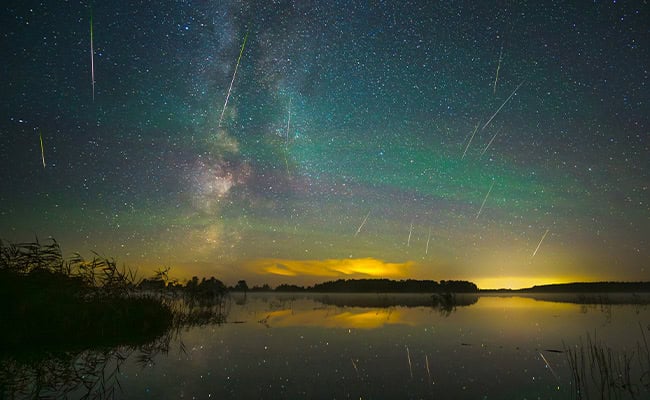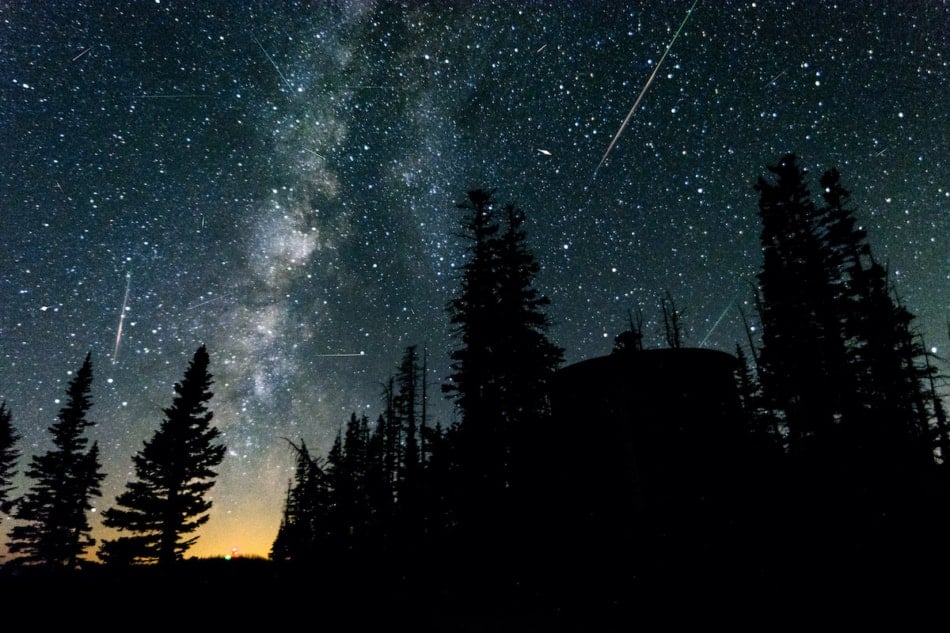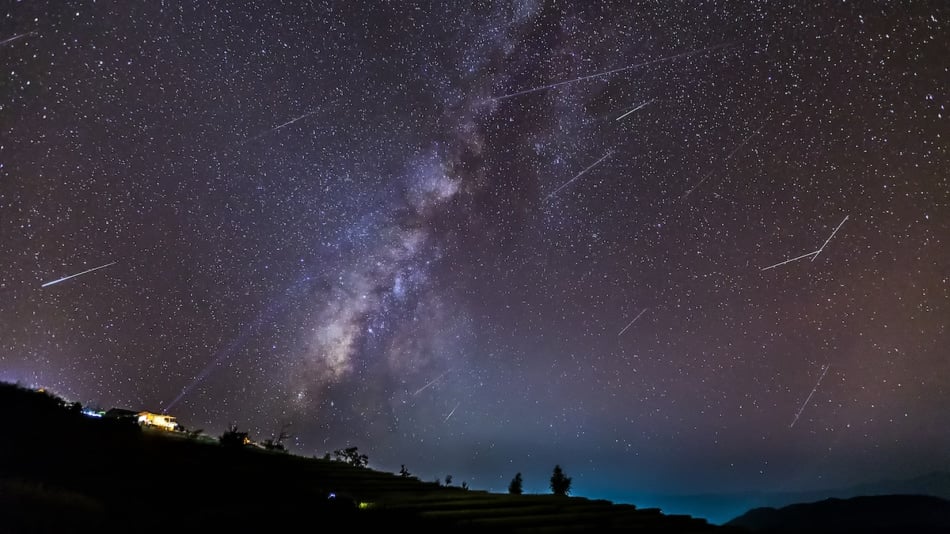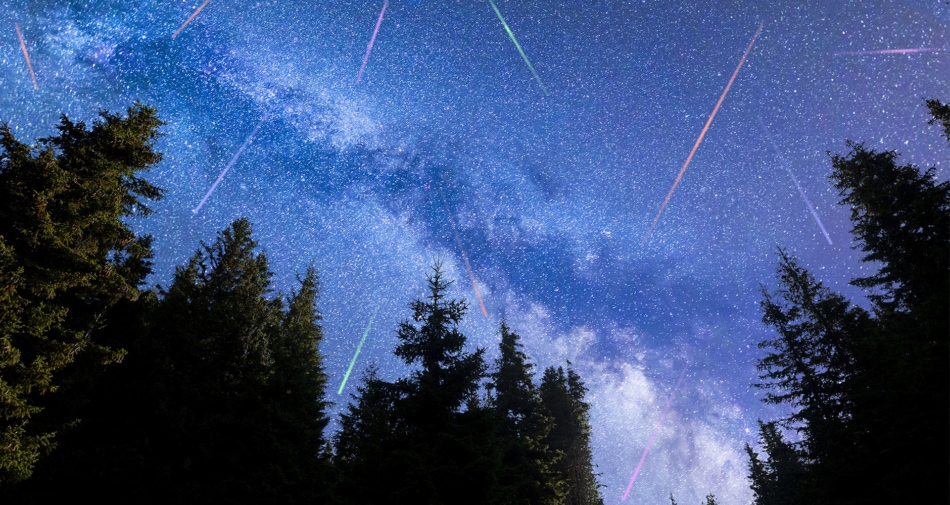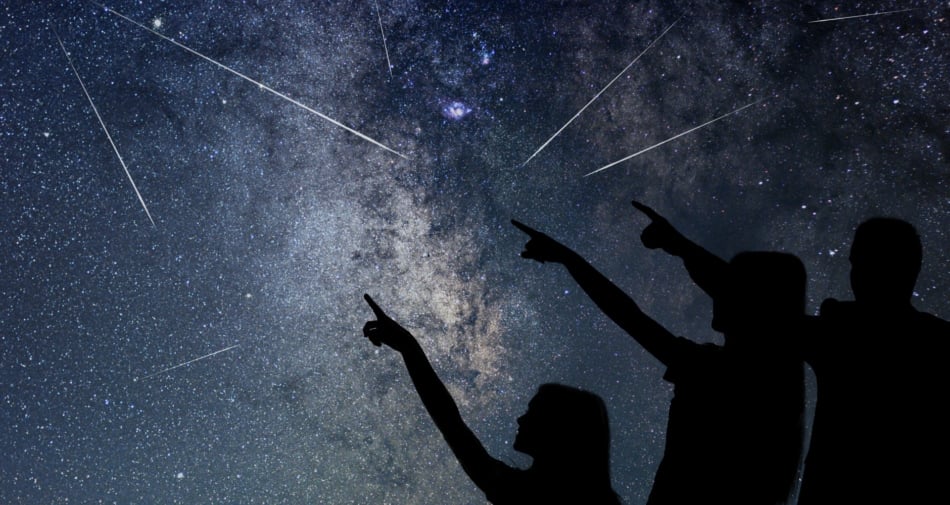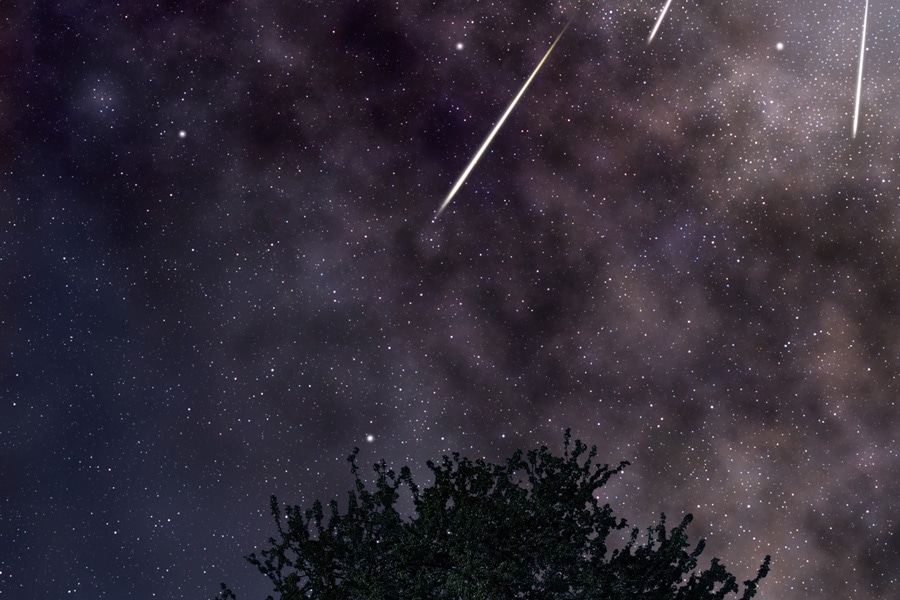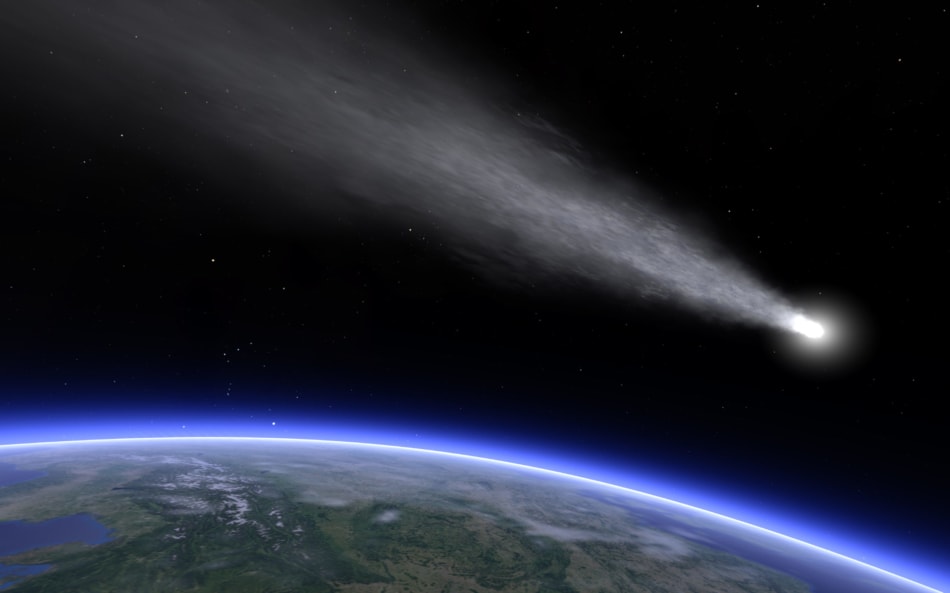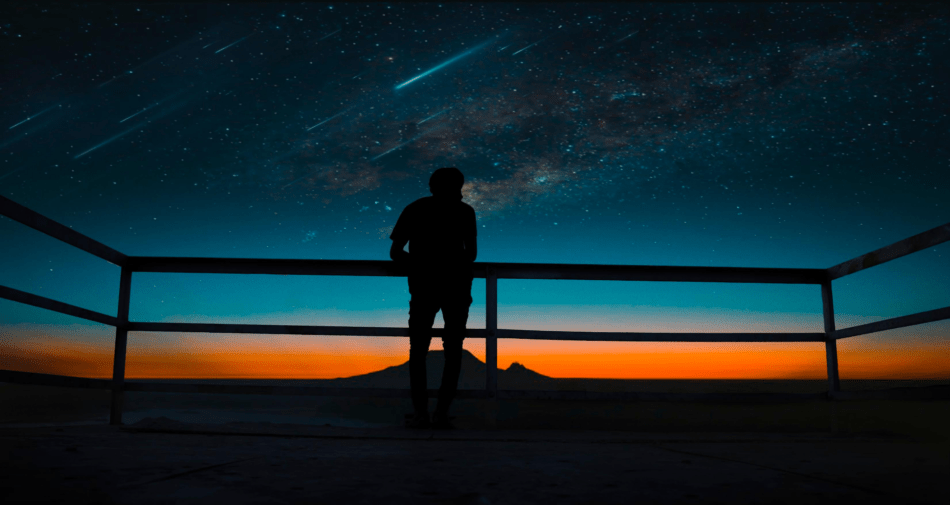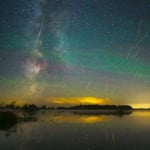Do you love shooting stars? Wondering if there is a meteor shower tonight? Here are some of the best-known meteor showers, when, and where to see them—followed by more details about each. Plus, meteor shower watching tips. Good luck—and be sure to share your experiences and any photos in the comments section!
Jump to meteor shower watching tips
Meteor Shower Season
Meteor shower season begins in the spring and ends in the winter. When gardens and wildlife wake up from winter’s sleep it’s as if the shooting stars do too—decorating the night with bright streaks! From the Lyrids to the Perseids, Geminids to the Quadrantids, each meteor shower has its own special charm.
As the year goes on, these showers come and go, their brightness increasing and decreasing. By the time January comes, the sky quiets down, and the major meteor showers seem to take a break.
This cycle is reminiscent of the old Roman calendar and the zodiac signs, which begin in spring. Just as the Earth starts fresh with the spring equinox, so does the cycle of shooting stars, mirroring the cycle of life through the four seasons.
Speaking of four seasons … Find out what the weather will be like all year!
When Is The Next Meteor Shower?
This chart lists the most well-known meteor showers as well as the Farmers’ Almanac recommendations for your best chances of catching a shooting star, based on predictions of each shower’s period of peak activity.
|
Meteor Shower Calendar 2024-2025
|
||||
|---|---|---|---|---|
| Meteor Shower Name | Dates of Peak Activity | Hourly Rate | Direction and Time* | Speed |
| Lyrids | Apr 21-22 | 10-20 | East and overhead 2 to 4 am | Swift streaks |
| Eta Aquarids | May 5-6 | 5-20 | Southeast 2 to 4 am | Very swift, long paths |
| Delta Aquarids | Jul 28-30 | 15-25 | South 1 to 3 am | Slow, long paths |
| Perseids | Aug 11-13 | 45-90 | Northeast 1 to 3 am | Very swift, rich display |
| Orionids | Oct 21-22 | 15-25 | South 2 to 4 am | Swift streaks |
| South Taurids | Nov 4-5 | 10-20 | South 1 to 3 am | Very slow, bright |
| North Taurids | Nov 12-14 | 10-20 | South 12 to 2 am | Slow fireballs |
| Leonids | Nov 16-17 | 10-15 | Southeast 4 to 5 am | Very swift |
| Geminids | Dec 13-14 | 60-120 | Overhead 1 to 3 am | Medium |
| Ursids | Dec 22-23 | 5-15 | North all night | Medium |
| Quadrantids | Jan 2-4 | 60-120 | Northeast 4 to 6 am | Medium |
February and March usually don’t have big meteor showers like the ones in other months. But you might still spot meteors on any night. It only takes clear skies and a little bit of luck! These meteors, which people often call “random” meteors, don’t belong to any specific meteor shower and may be seen all year-round.
Speaking of luck … Why is wishing on a shooting star believed to be good luck? Find out!
Meteor Shower Calendar 2024-2025
Here are more details about each of the meteor showers listed above, including your probability of seeing shooting stars based on the phase of the Moon during each period of peak activity.
We highly recommend: The Perseids (August), Geminids (December), and Quadrantids (January).
April 21-22, 2024: Lyrids (Of Lyra Constellation)
Named after the Lyra constellation, the Lyrid Meteor Shower will light up the sky from April 14 to 25, with the best viewing on the early morning of April 22. Look east and overhead between 2 and 4 a.m. local time. This shower comes from the area near the bright star Vega, which makes it easier to spot, even if you’re not sure where Lyra is.
Related: Learn more about Vega and the 10 Brightest Stars
If you happen to see a meteor during this time, it most likely will be dust from Comet Thatcher. These meteors light up as bright lines when they hit Earth’s atmosphere at really fast speeds (110,000 miles per hour).
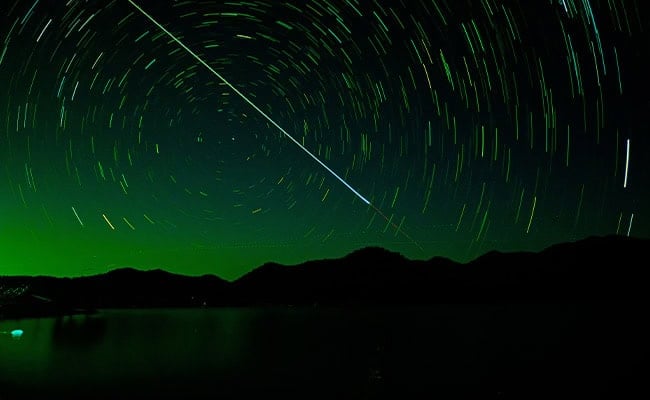
The Lyrids have been watched for over 2,000 years and usually show about 10 to 20 meteors per hour. Sometimes, like in 1982, there can be a lot more—up to 90 meteors in an hour.
2024 Observation Note: The full Moon might make it a bit harder to see shooting stars. Still, 10 to 15 meteors per hour may be visible if the weather conditions are perfect.
May 5-6: Eta Aquarids (Of Aquarius, Pegasus, And Pisces)
Catch a meteor this morning, when one of the year’s principal meteor showers—the Eta Aquarids—is due to reach its peak! Look southeast between 2 to 4 a.m. local time.
While the Eta Aquarids may not dazzle you with impressive numbers, this shower has one significant claim to fame: its particles come from the most famous of all comets: Halley’s comet! Their radiant is just a few degrees from the intersection of Aquarius, Pegasus, and Pisces.
Average rates tend to be about 5 to 20 per hour in the Northern Hemisphere and 60 or more per hour in the Southern Hemisphere. But do think of the Eta Aquarids as interplanetary postcards from the reigning king of comets, currently coasting out beyond the orbit of Neptune.
2024 Observation Note: Light from a waning crescent Moon in that part of the sky poses only a minor hindrance to spotting the faintest meteors. Shower activity will become noticeable once the radiant clears the eastern horizon at about 2:30 a.m. local daylight time. That’s when a bright Eta Aquarid may skim overhead, creating a long, dramatic “Earth-grazer.”
July 28-30: Delta Aquarids (Of Aquarius)
Several weak, long lasting meteor showers that primarily emanate from out of the southern part of the sky are active from mid-July through August. The best is the Delta Aquarid shower, due to peak during the predawn hours of July 29. From midnight until the first light of dawn, you can normally expect to see about 10 to 20 moderately swift meteors emanating from out of the southern part of the sky. (We recommend looking between 1 to 3 a.m.)
2024 Observation Note: This year, the chances of seeing a meteor during this time may not be optimal based on the presence of the Moon, just past last quarter phase, that will rise soon after midnight.
Related: Moon Phase Calendar
⭐ August 11-13: Perseids (Of Constellation Perseus)
Get set for one of the best sky events of the year! The Perseid Meteor Shower begins on July 25 and ends on August 18, but it is going to be at its best at around 11 p.m. on August 11 until dawn on August 12. (We recommend 1 to 3 a.m. on August 12.)
Related: Top Sky Events 2024
This yearly shower is famous for putting on a great show, usually sending 45 to 90 meteors across the sky every hour when it’s at its peak. If the sky is really dark, you might even see more!
Do you live in a big city? One of the best things about The Perseids is that they are bright meteors that break up and leave long, glowing trails, which can still be seen even where there are city lights.
2024 Observation Note: The last quarter Moon will set around 11 p.m., leaving the sky nice and dark for the shooting stars to shine through!
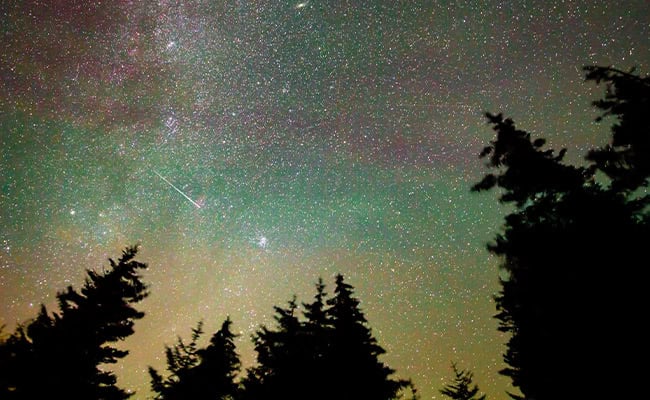
October 20-21: Orionids (Of Orion)
This year’s Orionid meteor shower is expected to peak early on the morning of October 21. Look south from 2 to 4 a.m. Under ideal conditions, you may be able to see up to 20 swift meteors might be seen per hour.
The meteors of this annual display have paths that appear to radiate from a spot between Gemini and Orion. A few Orionids may actually appear as early as the start of October and as late as November 7 or so.
2024 Observation Note: Unfortunately, the Moon is in a bright waning gibbous phase nearby Taurus, and its glare will very likely spoil the view this year.
Psst … did you know that the best time to stargaze is during a New Moon? Learn why!
November 5: Taurids (of Taurus)
November provides two great opportunities for meteor watching. Tonight marks the peak of the the Taurid Meteor Shower, which is known for its slow and bright meteors with impressive fireballs, radiating from the Taurus constellation.
What’s great about the Taurids is that they are one of the few meteor showers that may be observed in the evening! This makes seeing shooting stars tonight much easier for kids (and people who don’t want to stay up or wake up at 3 a.m.).
2024 Observation Note: About a dozen shower meteors per hour may be visible under dark skies after a waxing crescent moon sets in the early evening. Optimal time for viewing begins around 11 p.m. to midnight, when the Taurus constellation is directly overhead. We recommend looking south from 1 to 3 a.m. for best results.
The Taurids, specifically the Southern Taurids, are debris from Comet Encke. Although not the most abundant shower, their bright meteors make them worth observing from anywhere on Earth. You won’t need any special equipment—just look up.
November 16-17: Leonids (Of Leo)
Swift meteors of the Leonid swarm will streak away from the Sickle of Leo during the latter part of November, but probably in reduced numbers for most observers. The comet (55P/Tempel-Tuttle) that produces spectacular meteor displays at roughly 33-year intervals arrived at aphelion, beyond the orbit of Uranus in 2014, and as a result the Leonids have been weak in recent years. The maximum of this year’s display occurs this morning, when about 20 meteors per hour are predicted under ideal conditions.
2024 Observation Note: Unfortunately, your chances of spotting a meteor this morning may be ruined by a bright waning gibbous Moon in Taurus brightening the predawn skies. Look east about one hour before the break of dawn (approximately 4 to 5 a.m.) when the constellation Leo will be high in the eastern sky. The Leonids are known for leaving visible trains.
⭐ December 13-14: Geminids (Of Gemini)
The Geminid Meteor Shower, due to peak during the overnight hours of December 13-14, can produce as many as 60 to 120 slow, graceful meteors per hour under ideal conditions. They tend to be bright and appear yellow and have a reputation for occasional fireballs. Rates increase steadily for several days before maximum, then drop off quickly. The meteors that appear after maximum, however, tend to be especially bright.
Remember to dress warmly for the cold December night and perhaps bring along a warm drink to enhance your stargazing experience. The Geminids provide one of the best meteor viewing opportunities, not just for their quantity and brilliance, but also because they’re visible before midnight, making them accessible to many.
With the Geminids stemming from an asteroid rather than a comet, they offer a unique twist on the typical meteor shower narrative. Don’t miss out on this cosmic event that promises to enchant anyone willing to gaze up at the vast night sky.
2024 Observation Note: Despite the near-full Moon’s presence, the intensity and brightness of the Geminids ensure a spectacular show, with vivid colors that make them stand out against the night sky. Although the moonlight may conceal the faintest meteors, you’ll still be treated to an unforgettable display, especially if you position yourself with the Moon at your back. Look overhead from approximately 1 to 3 a.m.
⭐ January 2-4: Quadrantids (of Boötes)
Mark your calendars for January 3, 2025, for a spectacular night sky show! The Quadrantid Meteor Shower, known for its bright and quick appearance, will be at its best without the Moon’s light to interfere!
2025 Observation Note: This year, maximum activity for the “Quads,” which only lasts for a few hours, will occur at 10 a.m. EST and therefore will favor observers along the west coast of North America (7 a.m. PST) and Hawaii (5 a.m. HST). A single observer in these regions, between midnight and dawn might expect to see 40 to 60 of these moderately swift blue meteors per hour; across central and eastern North America, lesser numbers of around 20 to 30 per hour may be seen. The shower’s radiant is halfway between the head of Draco and the end of the Big Dipper’s handle in the predawn northeast sky.
The Quadrantids get their name from an old constellation called Quadrans Muralis, even though they seem to come from the constellation Boötes nowadays. This meteor shower has been wowing people since the 1830s when it was first noted by Adolphe Quetelet.
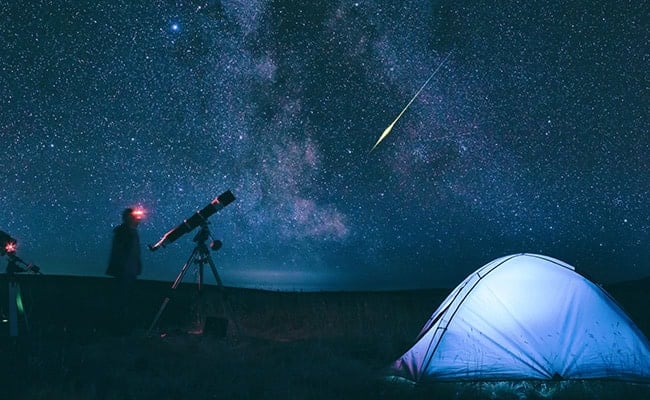
Catch Shooting Stars Tonight With Our Tips!
The best way to watch for meteors is to check your weather forecast, find a place with a clear view of the sky, and arrange comfortable deck chairs with pillows and blankets. Be sure to wear warm clothing—even in summer—as the nights and earlier morning can be colder than you might think!
Related: Farmers’ Almanac Extended Weather Forecast
Another factor to consider is bright moonlight, which can considerably cut into the potential number of meteors that might be seen. If a gibbous or full Moon is present during your meteor watch, its bright light will make seeing meteors difficult.
For a better experience, get away from city lights, give your eyes time to get used to the dark, and then just look up. Recline and relax with these ten essential tips, followed by suggestions for each season.
10 Essential Meteor Shower Tips
- Check the Weather: Before heading out, make sure to check the weather forecast for your location. Clear skies are essential for optimal viewing. Farmers Almanac Extended Weather Forecast
- Find a Dark Location: Choose a spot away from city lights to minimize light pollution and maximize visibility. Dark skies provide the best backdrop for meteor watching.
- Arrive Early and Be Patient: Give yourself plenty of time to get settled and let your eyes adjust to the darkness. Meteor showers can be unpredictable, so patience is key.
- Bring Comfortable Seating: Bring along a comfortable chair, blanket, or sleeping bag to sit or lie down on while you watch. Meteor showers can last for hours, so comfort is important.
- Dress Appropriately: Even in warmer months, nighttime temperatures can drop significantly. Dress in layers and wear warm clothing to stay comfortable during your viewing session.
- Avoid Bright Lights: Minimize the use of flashlights and electronic devices, as they can disrupt your night vision and make it harder to see meteors. If you need light, use a red flashlight instead.
- Look Towards the Radiant: Each meteor showers appears to radiate from a specific point in the sky known as the radiant. While some stargazers claim to see more shooting stars by looking directly towards the radiant, you may also have luck looking from your peripheral vision. As a general rule, the more sky you can see the better your chances are!
- Bring a Star Chart or Mobile App: Bring along a star chart or use a mobile app to help identify meteor shower radiants and constellations (mentioned in parenthesis after each meteor shower name above).
- Stay Hydrated and Snack: Bring along water and snacks to stay hydrated and energized during your meteor shower viewing. It’s easy to lose track of time while gazing at the sky.
- Enjoy the Moment: Take time to appreciate the beauty and wonder of the night sky. Meteor showers are rare and magical events, so relax, enjoy the experience, and make memories that will last a lifetime.
Spring Stargazing Tips
- Be Prepared for Variable Weather: Spring weather can be unpredictable, so check forecasts and be prepared for sudden changes in temperature and precipitation.
- Watch for Pollen: Springtime brings pollen and allergens that can irritate sensitive individuals. Consider taking allergy medication if needed.
- Take Advantage of Longer Days: With longer daylight hours in spring, plan your stargazing sessions for later in the evening to ensure darker skies.
Summer Stargazing Tips
- Stay Hydrated: Summer nights can still be warm, so be sure to stay hydrated by bringing plenty of water with you.
- Plan for Humidity: Summer humidity can lead to hazy skies and reduced visibility. Choose locations away from urban areas and sources of light pollution for clearer views.
- Use Bug Spray: Insects are often more active during summer evenings. Apply bug spray to deter mosquitoes and other pests.
- Consider Outdoor Fans: If you’re stargazing from your backyard or patio, consider using outdoor fans to keep cool and discourage insects.
Fall Stargazing Tips
- Watch for Clear Nights: Fall often brings clear, crisp nights ideal for stargazing. Keep an eye on weather forecasts and plan your stargazing sessions on nights with minimal cloud cover.
- Dress in Layers: Temperatures can vary greatly during fall evenings. Wear layers that you can easily add or remove as the night progresses.
- Bring Insect Repellent: Fall evenings may still have lingering mosquitoes and other insects. Apply insect repellent to prevent discomfort and distractions while stargazing.
Winter Stargazing Tips
- Bundle Up: Winter nights are cold, so dress warmly in layers and bring along hand and foot warmers to stay comfortable.
- Check for Icy Conditions: Watch out for icy patches, especially in areas with snow or freezing temperatures. Use sturdy footwear with good traction to prevent slips and falls.
- Protect Your Equipment: Cold temperatures can affect the performance of telescopes, binoculars, and cameras. Allow your equipment to acclimate to the outdoor temperature gradually to prevent fogging and condensation. Consider using dew shields or lens heaters to minimize moisture buildup.
- Take Breaks Indoors: If you start feeling too cold, take periodic breaks indoors to warm up before returning to stargazing.
- Minimize Exposed Skin: Cover up exposed skin to prevent frostbite and windburn. Apply moisturizer to protect against dryness and chapping.
- Check the Weather Forecast: Winter weather can be unpredictable, so be sure to check the forecast for any potential clouds or storms that could obstruct your view.
- Bundle Up: Winter nights can be bitterly cold, especially in open areas away from city lights. Dress in layers, including thermal undergarments, a warm coat, gloves, hat, and thick socks to stay comfortable and ward off the chill.
- Use Hand and Foot Warmers: Consider bringing along hand and foot warmers to keep extremities warm during prolonged periods of stargazing. Place them inside your gloves, pockets, or boots for added warmth.
- Bring Hot Beverages: Pack a thermos of hot cocoa, tea, or coffee to enjoy during your stargazing session. Not only will it help keep you warm, but it adds to the cozy winter experience.
Games To Pass The Time!
Here are some verbal games that are great for passing the time while stargazing with friends and family:
- Constellation Riddles: One person thinks of a constellation and gives clues about its shape, position in the sky, or mythological origin. Others try to guess the constellation based on the clues provided.
- Starry Sky Trivia: Prepare some astronomy trivia questions in advance or use a stargazing app to find interesting facts about celestial objects. Take turns asking questions and see who can answer the most correctly.
- Night Sky Storytelling: Build a collaborative story inspired by the stars. Start with one person beginning a story involving a constellation or celestial object visible in the sky. Then, each person adds a sentence or two to continue the story, incorporating elements from the night sky.
- Star Catalog Challenge: Challenge each other to identify as many constellations and stars as possible within a certain time limit. Use star charts or stargazing apps to help with identification.
- Astrological Guessing Game: One person describes the characteristics or traits associated with a particular zodiac sign, and others try to guess which sign it is. This game can lead to discussions about astrology and its connection to the night sky.
- Celestial Alphabet Game: Starting with the letter ‘A’, take turns naming celestial objects, such as stars, constellations, planets, or galaxies, that begin with each letter of the alphabet. See how far you can get before reaching ‘Z’!
These games can add an element of fun and engagement to your stargazing experience, encouraging interaction and learning while enjoying the wonders of the night sky with friends.
Suggestions For A Stargazing Picnic!
A nighttime picnic can be a delightful way to enjoy the meteor shower while indulging in delicious food and drinks. Here are some suggestions for a memorable nighttime picnic:
- Easy-to-Eat Finger Foods: Opt for a selection of easy-to-eat finger foods that are convenient to enjoy without utensils. Consider items like cheese and crackers, sliced fruits (such as grapes, apples, and berries), nuts, olives, and bite-sized sandwiches or wraps.
- Charcuterie Board: Create a charcuterie board with an assortment of cured meats, cheeses, bread or crackers, nuts, dried fruits, and spreads. Arrange the ingredients on a wooden board or platter for an elegant and visually appealing spread.
- Warm Beverages: Bring along thermoses filled with hot chocolate, mulled cider, or herbal tea to keep you warm and cozy during the chilly night. Consider adding a splash of cinnamon or a twist of citrus for extra flavor.
- Sweet Treats: Treat yourself to some sweet treats for dessert. Pack cookies, brownies, chocolate truffles, or fruit tarts to satisfy your sweet tooth while stargazing.
- Portable Snacks: Choose snacks that are easy to transport and enjoy outdoors. Pack individual servings of popcorn, trail mix, granola bars, or pretzels for a quick and convenient snack option.
- Picnic Blanket and Cushions: Bring along a comfortable picnic blanket or outdoor cushions to sit on while enjoying your meal. Choose blankets made from warm and cozy materials to keep you comfortable during the nighttime picnic.
- Stargazing Accessories: Don’t forget to bring stargazing accessories such as binoculars, telescopes, or star maps to enhance your celestial viewing experience. Consider downloading stargazing apps on your smartphone for an interactive guide to the night sky.
- Candlelight Ambiance: Create a romantic ambiance with flickering candlelight or battery-operated LED candles. Place candles in glass jars or lanterns to provide soft, ambient lighting while adding a touch of warmth to the picnic setting.
- Blankets and Layers: Since nighttime temperatures can be cooler, be sure to dress warmly and bring along extra blankets or layers to stay comfortable throughout the picnic. Consider wearing hats, scarves, and gloves to keep warm while stargazing.
- Waste-Free Picnicware: Use reusable picnicware such as plates, cups, utensils, and napkins to minimize waste and reduce environmental impact. Bring along a small garbage bag to collect any trash and dispose of it properly after the picnic.
With these suggestions, you can create a magical nighttime picnic experience that combines delicious food, cozy ambiance, and breathtaking views of the night sky during the meteor shower. Enjoy the celestial spectacle with loved ones and make lasting memories under the stars.
Join The Discussion
Did you see a shooting star from any meteor showers tonight? If so, which one?
What is one fond memory you have of catching a shooting star?
Share your experience with your community here in the comments below!
Related
Places With The Darkest Skies (And The Brightest Stars)
10 Great Places To Camping Under The Stars

